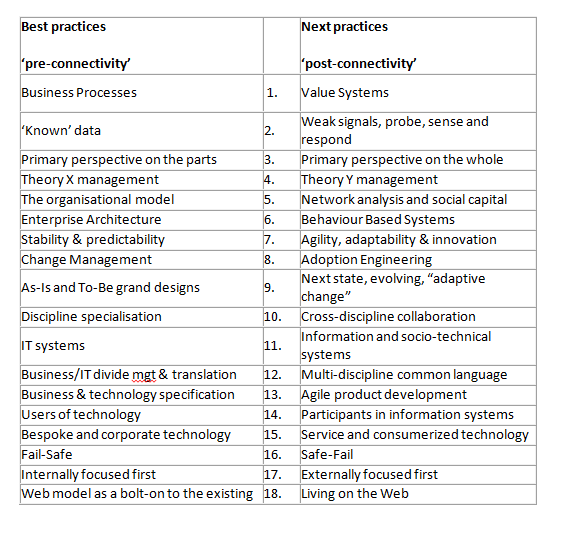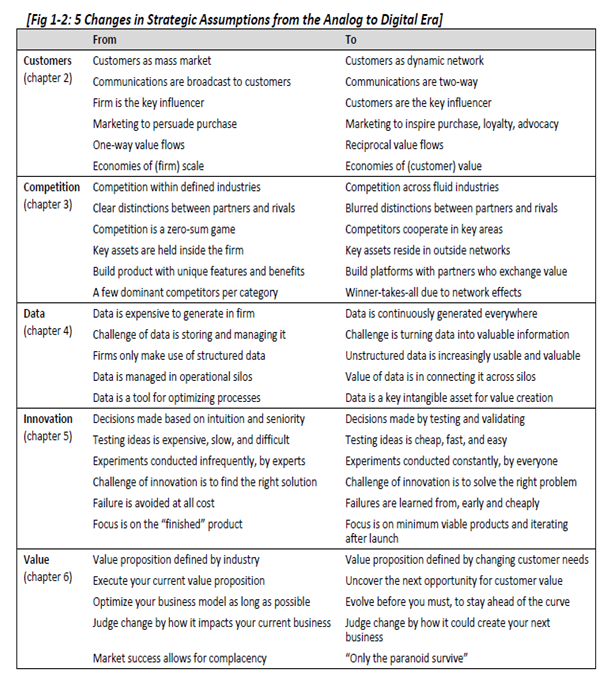 Often you hear the request made of “can you give us a best practice snapshot; we would like to get a sense of where we are”.
Often you hear the request made of “can you give us a best practice snapshot; we would like to get a sense of where we are”.
Firstly please forget best practice, this is a mistake for you in a rapidly changing world
The trouble with best practice is you are looking at someone else’s practices and these are highly individual, made up of different groups of methodologies, processes, rules, theories, values and concepts. These together have provided that specific company a level of success that others – mostly competitors – begin to notice and just attempt to copy.
No, there is no such thing as best practices, only your own distinct practices, specific to your own environment, history and needs, you can’t simply pick up and plug and play, as one organization’s initiative is never the same set of conditions or positioning that others can simply copy.
We desire the “one-size fits all” as a comfort blanket. Many consultants love this request, as they do not need to apply the real skills of discernment, subject matter expertise and the difficult challenge of peeling away a client’s practice to understand how they can rebuild them to become unique, into a leading practice that cannot be copied. Here lie a true competitive component and so many organizations seek to apply someone else’s practice, so they can end up as “same” practice.
Moving from “Best Practice” to “Next Practice”
The digital transformation that is underway is becoming a very uncomfortable place. We are all presently learning a new practice. The past best practices are now a very poor playbook for the future digital connected world. We need to ditch much of the endeavors that make up a legacy of past practice, and think forward, to which the term next practice becomes the learning spot.
Finding your best practice is extremely tough, it is often a “blind” adoption as you never fully appreciate how one company arrived at this point, whatever is claimed. It is far better that you quickly benchmark assorted practices across yours and also different industries and then stop and reflect. You need to invest a lot in researching, seeking out understanding, and then experimenting with your own needs to develop your emerging practices for digital transformation, believe me.
Just take a look at the recent report I compiled on digital transformation.
This is a meta report I have written and was released this last week, on the recent developments in digital transformation. It offers a selection of key visuals and overviews from 14 reports, which in turn were shortlisted from an original data set of 140 reports on the topic, published over the course of the last years. The intention of this report is to provide data for orientation for people dealing with this difficult topic.
The report should give you an opportunity to find connecting points in the understanding of digital transformation. The link provided below takes you to an access sign up page. Do please note the statement “
Forget the past, much of our roots need digging up and discarding.
No one can maintain the past, much of our systems are rooted in the 20th century, in markets that were predictable and where supply and demand were simply managed to seek out the status quo.
We are facing such an unprecedented change and technology is re-writing the rule book in everything we are going to do. Many have argued it is a foundational shift and today we are struggling to articulate or codify the shifts. We seem to be moving from the world of complicated into the complex. It is hitting us in multiple ways, in scale, in speed, and in scope, across the whole organization. Technology and digital are changing the business dimensions significantly.
We are moving from “pre-connectivity” to “post-connectivity
In this report I have been compiling writing on the topic of Digital Transformation, I have been attempting to find these emerging and next practices. It has been a very, very deep dive into this subject and it is full of different views, approaches, suggestions and recommendations. In the report due out in the next few weeks I have attempted to ‘pick out’ those practices that take you towards a new thinking for digital transformation.
What I have not included in the report are these two wonderful paradigm shifts we need to take to grasp digital transformation. I believe these should stand apart as they form the new ‘common language’ we need to apply to move into a digital transformation.
It is the critical shift from best (past) practice into next (new) practice
The first contribution is from a short article I came across in my research written for information-age by Carl Bate, managing partner, digital strategy and transformation, Atos
This emerging shift in leadership techniques, from best to next practice, from pre-connectivity to post-connectivity, are shown here:
 The practices of ‘best’ on the left-hand side are the very practices that have fostered industrialization and led to global connectivity.
The practices of ‘best’ on the left-hand side are the very practices that have fostered industrialization and led to global connectivity.
The irony is that these practices do not naturally foster external and connected views, which are essential to working in the connected world that the best practices have helped create.
The second contribution into thinking next practice comes from a really promising book by David L Rogers called “the Digital Transformation Playbook”, recently published in April 2016, and he is offering a superb list of changes to consider as we move from the Analog to the Digital Era.
The Author offers a view on how digital forces are reshaping five key domains of strategy—customers, competition, data, innovation, and value. These five domains describe the landscape of digital transformation for business today.
Many of the fundamental assumptions are outdated and he is suggesting we move from the Analog to Digital era, with his chapters in the book to work through these. This I think is such “next practice” thinking to get us in the digital era mind-set.
David Rogers sums up the change we are all facing from digital transformation
“We live in what is commonly referred to as a digital age. An overlapping ecosystem of digital technologies —each one building on those before, and catalyzing those to come—is transforming not only our personal and communal lives but the dynamics of business for organizations of every size and in every industry.
Digital technologies are transforming not just one aspect of business management, but virtually every aspect. They are rewriting the rules of customers, competition, data, innovation, and value. Responding to this change requires not just a piecemeal approach, but a total integrated effort—a process of holistic digital transformation within the firm.”
The key is to look forward and recognize past best practices are just not relevant today. We need to look forward and seek out those “next practices” that are emerging and explore them for what they mean for us, not for others. They are, or will become the (golden) keys to unlock the future common language of digital transformation, something we all are needing to learn.
Publishing note: This blog post was originally written on behalf of Hype and with their agreement, I have added this to my own site.
